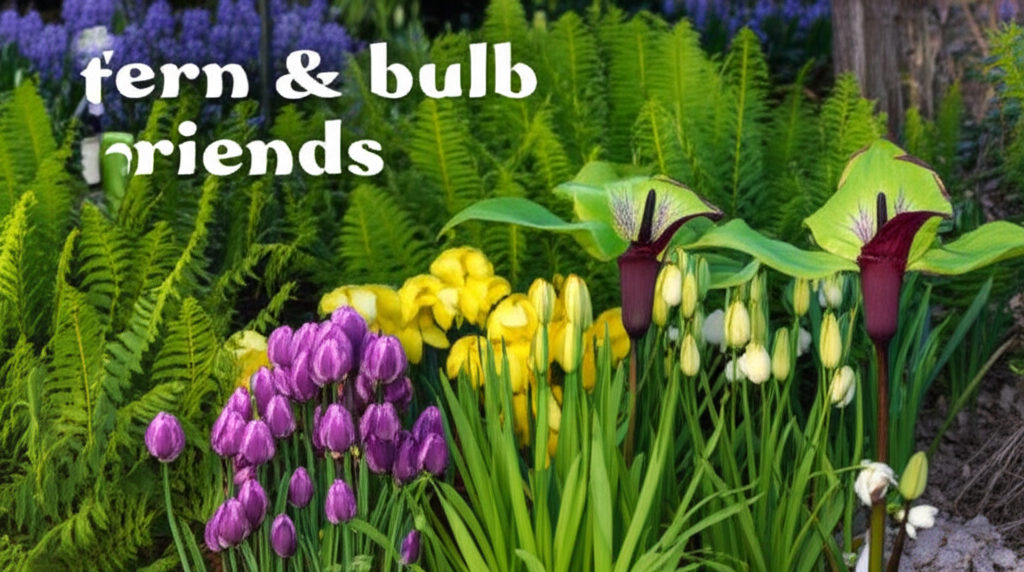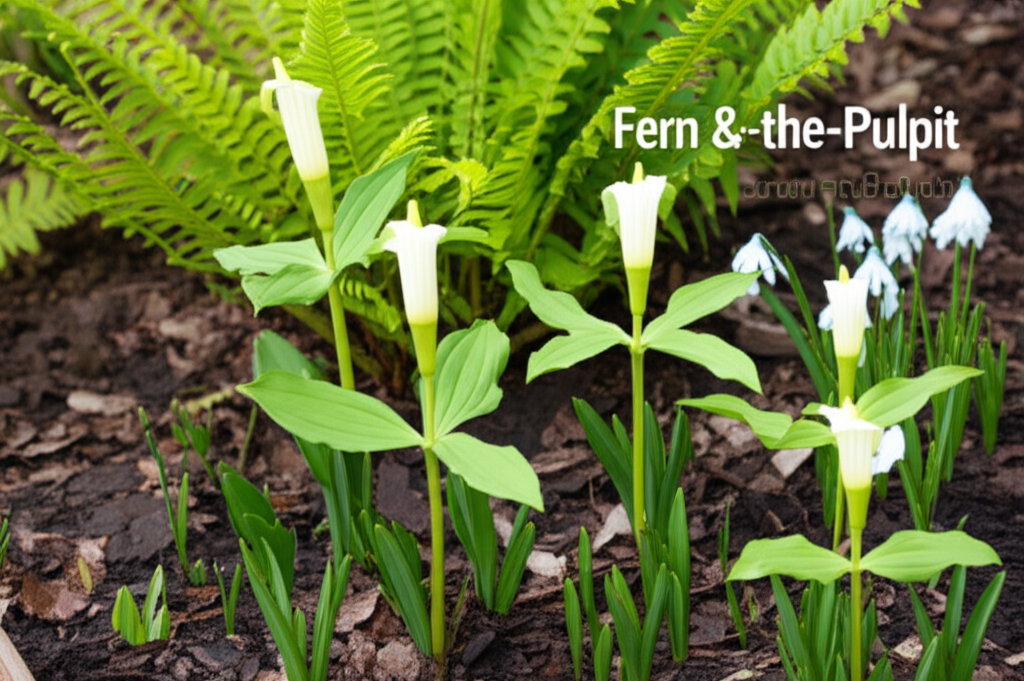Unveiling the Magic of Jack-in-the-Pulpit and Companion Planting
Jack-in-the-Pulpit (Arisaema triphyllum) is a captivating native wildflower that embodies the mystique of the woodland floor. With its unique spathe and spadix, often referred to as the “pulpit” and the “preacher,” this plant offers a fascinating botanical display. However, cultivating a truly successful and aesthetically pleasing Jack-in-the-Pulpit requires more than just its solitary beauty. Companion planting, the practice of growing compatible plants together, can significantly enhance the health, vitality, and visual appeal of your woodland garden, with Jack-in-the-Pulpit as the star.
This article delves into the art and science of companion planting specifically for Jack-in-the-Pulpit, focusing on its ideal partners: ferns and spring bulbs. We will explore why these plant groups are so well-suited, the benefits they bring to the ecosystem, and practical advice on creating a harmonious and thriving native plant display.
The Unique Needs of Jack-in-the-Pulpit

Before we discuss its companions, understanding the fundamental needs of Jack-in-the-Pulpit is crucial. This woodland native thrives in specific conditions that mimic its natural habitat.
- Soil: Rich, moist, well-drained, humus-rich soil is paramount. It prefers acidic to neutral pH.
- Light: Dappled shade or partial shade is ideal. Direct, harsh sunlight can scorch its leaves.
- Moisture: Consistent moisture is key, especially during its active growing season. It dislikes waterlogged conditions but also cannot tolerate prolonged dryness.
- Dormancy: Jack-in-the-Pulpit goes dormant in late summer or early fall after its berries mature, disappearing from view until the following spring.
These specific requirements inform our choice of companion plants, as they must be able to coexist and even mutually benefit from these same conditions.
Ferns: The Elegant Understory Companions
Ferns are arguably the most natural and aesthetically pleasing companions for Jack-in-the-Pulpit. Their foliage, ranging from delicate to robust, creates a lush and textured backdrop that perfectly complements the unique form of the Arisaema.
Why Ferns Are Ideal Companions
The symbiotic relationship between Jack-in-the-Pulpit and ferns is rooted in shared environmental preferences and complementary growth habits.
- Similar Habitat Needs: Most native woodland ferns, such as Christmas Fern (Polystichum acrostichoides), Lady Fern (Athyrium filix-femina), and Maidenhair Fern (Adiantum pedatum), thrive in the same dappled shade, moist, and humus-rich conditions that Jack-in-the-Pulpit prefers.
- Soil Improvement: As ferns decompose, they contribute organic matter to the soil, further enriching it and retaining moisture – crucial for the Arisaema.
- Mulching Effect: The dense foliage of ferns can act as a natural mulch, helping to keep the soil cool and moist, and suppressing weed growth around the base of the Jack-in-the-Pulpit.
- Aesthetic Harmony: The feathery or lacy textures of fern fronds provide a beautiful textural contrast and visual depth to the more architectural structure of the Jack-in-the-Pulpit.
- Extended Season of Interest: While Jack-in-the-Pulpit emerges in spring and often disappears by late summer, many ferns offer a much longer display, providing greenery and interest throughout the growing season and even into winter for evergreen varieties like Christmas Fern.
Key Fern Varieties for Companion Planting
When selecting ferns, consider their mature size and growth habit to ensure they don’t overpower the Jack-in-the-Pulpit.
- Christmas Fern (Polystichum acrostichoides): An excellent evergreen option, its stiff, dark green fronds provide winter interest and protection. It’s adaptable to a range of shade conditions.
- Lady Fern (Athyrium filix-femina): Known for its delicate, feathery fronds, Lady Fern adds a graceful touch. It prefers consistent moisture and can tolerate slightly more sun than some other woodland ferns.
- Maidenhair Fern (Adiantum pedatum): With its fan-shaped leaflets and wiry black stems, Maidenhair Fern is incredibly elegant. It requires consistent moisture and protection from harsh winds.
- Ostrich Fern (Matteuccia struthiopteris): This tall, architectural fern can create a dramatic backdrop. However, be mindful of its spreading habit; it’s best planted where it has room to expand or in contained areas.
- Sensitive Fern (Onoclea sensibilis): Named for its susceptibility to frost, this fern has coarse, upright fronds that add a bold texture. It thrives in moist to wet conditions and can tolerate more sun.
Spring Bulbs: The Early Bloomers and Soil Enrichers
Spring bulbs offer a vibrant burst of color and early season energy to the woodland garden, creating a stunning prelude to the emergence of Jack-in-the-Pulpit. Their blooming times often precede or coincide with the initial unfurling of Arisaema leaves, making for a layered and dynamic display.
The Benefits of Pairing Bulbs with Jack-in-the-Pulpit
The partnership between spring bulbs and Jack-in-the-Pulpit is a classic woodland gardening strategy for several good reasons.
- Early Season Color: Bulbs like trilliums, trout lilies, and native violets are among the first to emerge, providing welcome color and life to the awakening woodland.
- Nutrient Cycling: As bulbs complete their growth cycle and go dormant, their foliage dies back, returning valuable nutrients to the soil. This benefits the subsequent growth of Jack-in-the-Pulpit and ferns.
- Ground Cover: Many spring-blooming bulbs form a natural ground cover that helps retain soil moisture and suppress weed seedlings before the taller foliage of Arisaema and ferns fully develops.
- Minimal Competition: Most spring bulbs complete their energy production and foliage die-back by early summer, at which point Jack-in-the-Pulpit and ferns are in their prime. This staggered growth cycle minimizes direct competition for resources.
- Attracting Pollinators: The early blooms of spring bulbs provide essential nectar and pollen for early-emerging pollinators, contributing to a healthy garden ecosystem.
Recommended Spring Bulbs for Woodland Gardens
Focus on native spring ephemerals and woodland-adapted bulbs for the most successful and ecologically sound pairings.
- Trilliums (Trillium spp.): Particularly Red Trillium (Trillium erectum) and White Trillium (Trillium grandiflorum), these iconic woodland flowers emerge with Jack-in-the-Pulpit and share similar soil and light needs.
- Trout Lily (Erythronium americanum): Also known as Adder’s Tongue, this plant’s mottled leaves and nodding yellow flowers are a sign of spring’s arrival. It prefers moist, well-drained soil.
- Wild Ginger (Asarum canadense): While not a true bulb, its rhizomatous roots and heart-shaped leaves emerge early, forming a lovely groundcover at the base of larger plants.
- Virginia Bluebells (Mertensia virginica): These delightful plants offer clusters of sky-blue, bell-shaped flowers in early spring. They enjoy moist soil and can tolerate partial shade.
- Spring Beauty (Claytonia virginica): One of the earliest bloomers, this small plant with pink-striped white flowers is a welcome sight. It spreads readily in suitable conditions.
Key Facts and Comparison Table
To help visualize the benefits of companion planting Jack-in-the-Pulpit with ferns and spring bulbs, consider this comparative overview:
| Feature | Jack-in-the-Pulpit | Ferns (General) | Spring Bulbs (General) |
|---|---|---|---|
| Preferred Light | Dappled/Partial Shade | Dappled/Partial Shade | Dappled/Partial Shade |
| Preferred Soil | Moist, Humus-Rich, Well-Drained | Moist, Humus-Rich, Well-Drained | Moist, Humus-Rich, Well-Drained |
| Primary Bloom/Foliage Time | Spring to Early Summer | Spring to Fall (some evergreen) | Early Spring |
| Aesthetic Contribution | Unique architectural form, berries | Textural variety, lush green backdrop | Early season color, ground cover |
| Ecological Benefit | Native pollinator support, wildlife food (berries) | Habitat, soil enrichment | Early pollinator support |
| Dormancy Pattern | Late Summer/Early Fall | Varies (some evergreen) | Early Summer |
Establishing Your Woodland Companion Planting Scheme
Creating a successful companion planting arrangement involves careful planning and execution. Here are the steps to get you started:
Steps to Planting Success
- Site Selection: Choose a location that receives dappled or partial shade throughout the day, ideally protected from harsh winds.
- Soil Preparation: Amend the soil with generous amounts of compost or leaf mold to improve fertility and moisture retention. Ensure good drainage.
- Plant Placement:
- Plant Jack-in-the-Pulpit corms in early spring or fall, about 3-4 inches deep, with the pointed end up.
- Place ferns around and behind the Jack-in-the-Pulpit to create a layered effect. Consider their mature spread to avoid overcrowding.
- Tuck spring bulbs in between the Jack-in-the-Pulpit and around the ferns, aiming for naturalistic drifts.
- Watering: Water thoroughly after planting and maintain consistent moisture, especially during dry spells.
- Mulching: Apply a layer of organic mulch, such as shredded bark or compost, to help retain moisture, suppress weeds, and regulate soil temperature.
- Observation: Monitor your plants for any signs of stress, pests, or diseases and adjust care as needed.
Pros and Cons of Companion Planting
Like any gardening practice, companion planting has its advantages and disadvantages.
| Pros | Cons |
|---|---|
| Enhanced plant health through nutrient sharing and pest deterrence. | Potential for overcrowding if plant spacing is not managed. |
| Improved soil structure and moisture retention. | May require careful selection to avoid allelopathic interactions (though less common with these specific pairings). |
| Increased biodiversity and attraction of beneficial insects. | Initial planning and design can be more complex than monoculture planting. |
| Extended season of interest with varied bloom times and foliage. | Some companions may have different watering needs, requiring careful site selection. |
| Aesthetically pleasing, creating a naturalistic and layered look. | May take longer to establish a mature, cohesive look compared to individual specimens. |
Addressing Potential Challenges
While the pairing of Jack-in-the-Pulpit with ferns and spring bulbs is generally harmonious, a few considerations can help ensure long-term success.
Overcrowding and Competition
As plants establish and mature, they can begin to compete for space, light, and nutrients.
- Spacing: Always research the mature size of your chosen plants and provide adequate spacing accordingly. It’s often better to plant a bit further apart initially and allow them to fill in.
- Pruning and Division: For aggressive spreaders like Ostrich Ferns or certain bulb varieties, occasional division or trimming may be necessary to maintain balance.
- Observation: Regularly observe the growth habits of your plants. If one species appears to be consistently outcompeting another, intervention may be required.
Watering Consistency
While all these plants prefer consistent moisture, the exact needs can vary slightly.
- Monitoring: Regularly check soil moisture levels by feeling the soil a few inches down.
- Adjustments: In prolonged dry spells, ensure all plants are receiving adequate water. Conversely, ensure good drainage to prevent waterlogging, especially for the Jack-in-the-Pulpit.
Conclusion: Cultivating a Woodland Masterpiece
Companion planting Jack-in-the-Pulpit with ferns and spring bulbs is a rewarding endeavor that creates a dynamic, beautiful, and ecologically sound woodland garden. By understanding the specific needs of the Jack-in-the-Pulpit and selecting compatible partners like the lush foliage of ferns and the early bursts of color from spring bulbs, you can foster a thriving miniature ecosystem. This practice not only enhances the aesthetic appeal of your garden but also contributes to the health and vitality of the native plant community, offering a truly magical experience for any nature enthusiast. Embrace the art of thoughtful pairings, and watch your woodland garden come alive.


